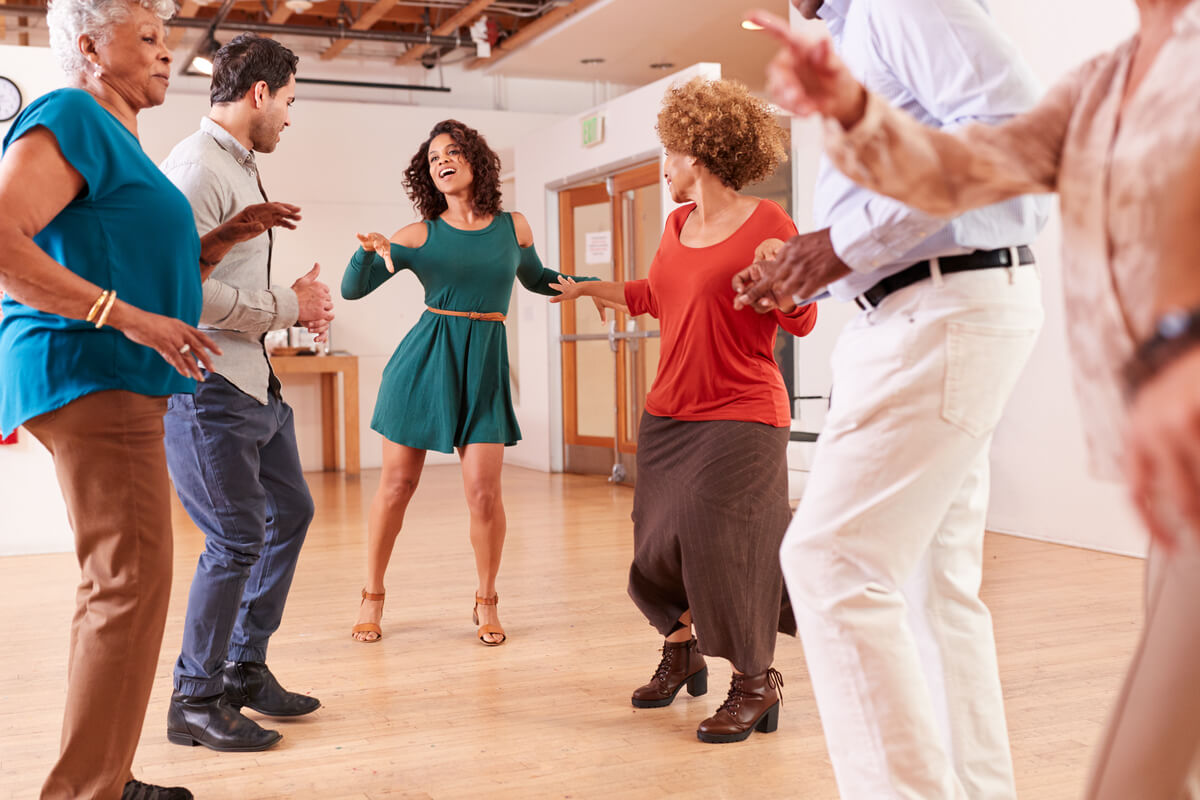How Dancing Improves Quality of Life

Dancing brings many benefits, both physically and emotionally. These can be enjoyed by people of all ages and genders, and any type of dance is beneficial. Let’s look at how dancing improves quality of life in this article!
To encourage you to take part in this activity, we have focused only on the benefits of dancing that have been studied by scientists, although we could cite dozens and dozens of them.
So, without further ado, stay with us as we look at how dancing improves quality of life.
7 ways that dancing improves quality of life
There are no hard and fast rules when it comes to learning to dance. Many choose to teach themselves, while others rely on a teacher or instructor and sign up for dance classes. Whatever option you choose is fine, and all of them benefit you in the following way.

1. It reduces stress and anxiety
A study published in Frontiers in Psychology in 2019 found that dancing can reduce or control levels of stress, anxiety and depression.
Dancing is, in many ways, a similar activity to doing sport, only with slightly lower intensity. Physical activity is recommended for people who suffer from all of these emotional disorders, and this has been scientifically proven.
2. Strengthen your self-esteem
Another psychological aspect in which dancing improves quality of life is through self-concept. An article published in Frontiers in Psychology in 2018 found a number of benefits of dancing for children, adolescents and adults.
In children and teenagers, it helps to foment a better body self-image, as well as self-confidence, self-esteem and self-expression.
In adults, on the other hand, it can improve self-expression, self-efficacy, self-awareness, body awareness, self-development, and self-confidence.
Dancing strengthens our self-perception in many different ways, and the benefits are felt within a few weeks. Those related to the body (such as body image) are the strongest of all of them.
3. Improves your cognitive skills
Cognitive flexibility is the brain’s ability to adapt our behavior and thinking to changing situations, ideas, and points of view. According to researchers, dance has a positive impact on cognitive plasticity. Older adults can especially benefit from dance in this sense, but there are benefits for everyone.
4. It can help in chronic illnesses
A study published in Heliyon in 2019 found that dancing is recommended for people with chronic diseases. We can especially highlight diabetes, Parkinson’s disease, fibromyalgia, multiple sclerosis, rheumatoid arthritis, obesity, and Alzheimer’s disease, but there are also many others.
Physical activity is recommended for all of these conditions, and it can bring both physical and emotional benefits. Since the options are limited (and this varies from case to case), dance can be used as an excellent option. However, we suggest consulting a specialist before including it as part of the person’s daily routine.

5. Widens your social circle
Another way dancing can improve quality of life is by widening your social circle. So says research published in 2020 in The International Journal of Qualitative Studies on Health and Well-Being.
While it’s true that you can dance alone, many people choose to do it with another person or in a group. This results in a widening of your social circle, helping you meet and share with different people.
6. It improves your posture and balance
There’s also evidence that dancing can help improve balance and posture. In theory, this could reduce the risk of falls, and improve coordination and mobility. It’s clear that this will greatly benefit older people, but it’s also helpful for children, teens, and young adults.
For example, those who suffer from vestibular balance disorders, motor development problems, back pain due to a bad posture, and so on, can all benefit from dance. It’s a very versatile practice that’s easily adaptable to all ages and sexes. We really want to reiterate this, so that we don’t only associate the benefits of dancing with increased quality of life in old age.
7. It can relieve fatigue
Finally, specialists have also found that dancing improves quality of life by helping us to rest and overcome cardiovascular, central nervous system, musculoskeletal, and psychological fatigue. This particular benefit of dancing is especially relevant when the practice is accompanied by music (as is regularly the case). The classes can thus become a place to rest and somewhere you can escape from the exertions of the day.
As we have explained in this article, dancing can improve quality of life in many different ways. We have only been able to focus on 7 of them, but we’re sure that they have shown you just how practical and useful it is and how it can bring true well-being. So, be sure to sign up for dance classes or practice on your own with friends and family.
References:
• Alpert PT, Miller SK, Wallmann H, Havey R, Cross C, Chevalia T, Gillis CB, Kodandapari K. The effect of modified jazz dance on balance, cognition, and mood in older adults. J Am Acad Nurse Pract. 2009 Feb;21(2):108-15.
• Bruyneel AV. Effects of dance activities on patients with chronic pathologies: scoping review. Heliyon. 2019;5(7):e02104.
• Coubard OA, Duretz S, Lefebvre V, Lapalus P, Ferrufino L. Practice of contemporary dance improves cognitive flexibility in aging. Front Aging Neurosci. 2011;3:13.
• Jing L, Xudong W. Evaluation on the effects of relaxing music on the recovery from aerobic exercise-induced fatigue. J Sports Med Phys Fitness. 2008 Mar;48(1):102-6.
• Koch SC, Riege RFF, Tisborn K, Biondo J, Martin L, Beelmann A. Effects of Dance Movement Therapy and Dance on Health-Related Psychological Outcomes. A Meta-Analysis Update. Front Psychol. 2019;10:1806.
• Sheppard A, Broughton MC. Promoting well-being and health through active participation in music and dance: a systematic review. Int J Qual Stud Health Well-being. 2020;15(1):1732526.
• Schwender TM, Spengler S, Oedl C, Mess F. Effects of Dance Interventions on Aspects of the Participants’ Self: A Systematic Review. Front Psychol. 2018;9:1130.
This text is provided for informational purposes only and does not replace consultation with a professional. If in doubt, consult your specialist.








